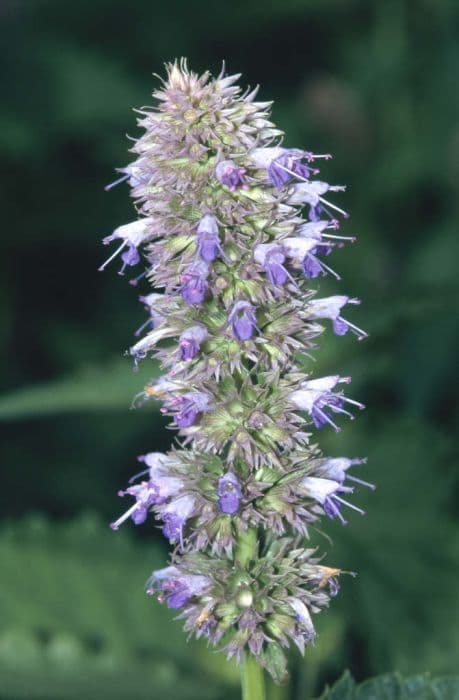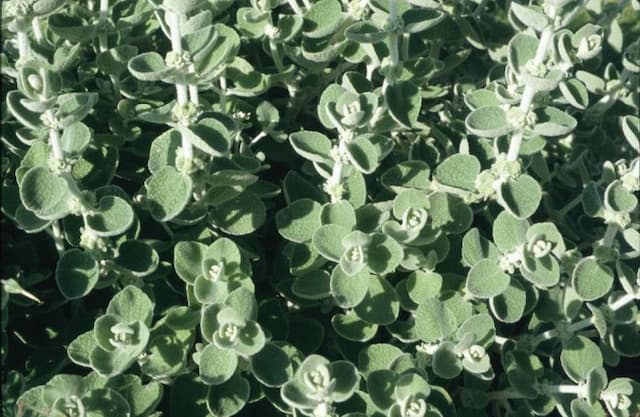British wild thyme Thymus polytrichus A. Kern. ex Borbás subsp. britannicus (Ronniger) Kerguélen

ABOUT
The plant commonly known as wild thyme has a bushy appearance with woody stems. Its foliage is made up of small, oval to linear-shaped leaves, which are arranged oppositely along the stems. These leaves are typically green, sometimes with a grayish tint, and are covered with fine hairs, giving them a somewhat fuzzy appearance. During the blooming period, the plant is adorned with clusters of tiny flowers. The flowers are usually purple or lilac and are tubular with two lips that serve as landing platforms for pollinators such as bees. These flowers are grouped in whorls at intervals along the stem, forming a more or less dense inflorescence. The whole plant is aromatic, releasing a pleasant, pungent scent when the leaves are crushed or rubbed, a characteristic that makes wild thyme not only aesthetically pleasing but also a valuable herb in cooking and herbal medicine. The plant is hardy and well-adapted to various conditions, often found growing in rocky or sandy soils. Its growth form allows it to spread across the ground, creating a mat-like cover that can be quite dense and extensive.
About this plant
 Names
NamesSynonyms
British Wild Thyme, Breckland Thyme
Common names
Thymus britannicus Ronniger, Thymus praecox subsp. britannicus (Ronniger) Jalas
 Toxicity
ToxicityTo humans
Wild thyme is not known to be toxic to humans when consumed in normal food quantities. As with any plant, allergic reactions are possible, and consuming excessively large amounts should be avoided. If you suspect you have ingested a part of wild thyme and feel unwell, it is advisable to consult with a healthcare professional. Generally, it is considered safe for culinary uses.
To pets
Wild thyme is not considered toxic to pets. It is often used as a safe, aromatic herb in gardens where pets may roam. However, individual animals may have different sensitivities, so it is advisable to monitor your pet for any signs of digestive upset or allergic reactions after ingestion. If any adverse effects are observed, consult with a veterinarian.
 Characteristics
CharacteristicsLife cycle
Perennials
Foliage type
Evergreen
Color of leaves
Green
Flower color
Pink
Height
0.5 feet (15 cm)
Spread
1 feet (30 cm)
Plant type
Herb
Hardiness zones
5
Native area
Europe
Benefits
 General Benefits
General Benefits- Culinary Uses: Thymus polytrichus, commonly known as Wild Thyme, can add flavor and aroma to a variety of dishes, including meats, soups, and sauces.
- Gardening: Wild Thyme is a low-maintenance, drought-tolerant plant often used for ground cover, rock gardens, and as an ornamental.
- Habitat for Wildlife: It provides food and habitat for pollinators such as bees and butterflies, contributing to local biodiversity.
- Soil Erosion Control: The plant's mat-forming habit helps to stabilize the soil and prevent erosion, especially on slopes and in rocky areas.
- Aesthetic Appeal: It has attractive flowers and foliage, making it a pleasing addition to the landscape.
- Culinary Herb Garden: Suitable for a herb garden, it provides fresh herbs for culinary use throughout the growing season.
- Low Allergenic Potential: The plant is generally not known to cause allergies, making it suitable for planting in public spaces and gardens.
- Fragrance: The leaves and flowers, when crushed or brushed against, release a pleasant scent that can enhance the sensory experience of a garden.
 Medical Properties
Medical Properties- This plant is not used for medical purposes.
 Air-purifying Qualities
Air-purifying QualitiesThis plant is not specifically known for air purifying qualities.
 Other Uses
Other Uses- Wild Thyme, the common name for Thymus polytrichus subsp. britannicus, can be used as a flavoring for meat dishes, adding a subtle herby taste.
- It serves as a fragrant stuffing spice blend for poultry, complementing other traditional herbs like sage and rosemary.
- Used as a natural aromatic additive in potpourris, Wild Thyme imbues a gentle forest-like scent to the mix.
- This plant can be incorporated into natural dye processes, where different parts can yield varying shades on wool or fabric.
- Its low-growing, creeping nature makes Wild Thyme an excellent ground cover for garden landscapes, providing greenery and withstanding foot traffic.
- Wild Thyme flowers attract beneficial insects to the garden, such as bees and butterflies, supporting pollination.
- The dried leaves of Wild Thyme can be used in linen sachets to impart a fresh scent to clothes and deter moths.
- When thrown onto a fire, the plant can act as a natural incense, creating a calming and pleasant-smelling smoke.
- The plant can be used as an ingredient in handmade soaps, giving the final product an exfoliating texture and herbal fragrance.
- Wild Thyme can be added to homemade syrups or infusions to create unique flavors in cocktails or non-alcoholic beverages.
Interesting Facts
 Feng Shui
Feng ShuiThe plant name is not used in Feng Shui practice
 Zodiac Sign Compitability
Zodiac Sign CompitabilityThe plant name is not used in astrology practice
 Plant Symbolism
Plant Symbolism- Courage and Bravery: Thymus polytrichus, commonly known as wild thyme, has been historically associated with courage. In ancient times, knights would often carry sprigs of thyme as a sign of bravery.
- Healing and Cleansing: With its antiseptic and medicinal properties, wild thyme symbolizes healing. It was used in traditional medicine to help treat various ailments.
- Purity and Peace: The purifying nature of thyme, due to its pleasant aroma, made it a symbol of purity and peace. It was often included in rituals to cleanse and ensure a peaceful environment.
- Passage and Transition: Wild thyme has been used in burial rites and is believed to aid in the transition to the afterlife, symbolizing eternal rest and the passage from one state of being to another.
 Water
WaterWild thyme should be watered sparingly, as the plant prefers a well-draining soil that is not overly moist. Aim to water young plants or newly transplanted ones more often to ensure they establish well—about once a week if there hasn't been significant rainfall. For established plants, water only when the soil feels dry to the touch, which typically equates to once every two weeks, with approximately one gallon per square yard during each watering session. Adjust the frequency according to weather conditions; reduce watering in rainy or cooler periods and increase slightly during prolonged dry spells or extreme heat.
 Light
LightWild thyme thrives best in full sunlight, enjoying at least six hours of direct sunlight each day. The optimal location for wild thyme is a south-facing spot where it can bask in the sun's rays without being shaded. If planted indoors, a sunny windowsill that receives ample daylight would be ideal.
 Temperature
TemperatureWild thyme is hardy and can tolerate a range of temperatures but grows best in conditions between 60°F and 70°F. The plant can survive temperatures as low as -20°F and as high as 90°F, making it suited for many temperate climates. It's important to protect it from extreme cold winds and frost, which can damage the plant even though it's resilient.
 Pruning
PruningPrune wild thyme to promote denser growth and maintain its shape, as well as to remove any dead or woody stems. The best time for pruning is in early spring or immediately after the plant has flowered. Pruning once or twice per year is adequate; cut back the plant by about a third to encourage new growth.
 Cleaning
CleaningAs needed
 Soil
SoilWild thyme (Thymus polytrichus subsp. britannicus) thrives best in well-draining soil with a slightly acidic to neutral pH, ideally ranging from 6.0 to 7.5. A mix containing equal parts of loamy soil, sand, and peat is optimal. To enhance drainage, which is crucial for this Mediterranean herb, consider adding perlite or gravel to the mix.
 Repotting
RepottingWild thyme does not require frequent repotting and can be done every 2-3 years or when the plant has outgrown its current pot. The best time for repotting is in the spring, just before the new growth starts.
 Humidity & Misting
Humidity & MistingWild thyme prefers a dry to moderate humidity environment. It does well with the average humidity levels found in most homes, around 30-50%. Excess humidity can lead to fungal issues, so it's critical to maintain good air circulation around the plant.
 Suitable locations
Suitable locationsIndoor
Place in sunny spot, water sparingly.
Outdoor
Choose sunny location; well-draining soil.
Hardiness zone
5-9 USDA
 Life cycle
Life cycleThymus polytrichus, commonly known as wild thyme or creeping thyme, begins its life cycle as a seed, which upon finding suitable conditions—well-drained soil and plenty of sunlight—germinates to produce a tiny seedling. The seedling develops into a young plant, forming a taproot and a small rosette of leaves while it establishes itself. As it matures, it enters the vegetative growth phase, producing a dense, mat-like ground cover with small, fragrant, green leaves and woody stems through vegetative propagation. Upon reaching reproductive maturity, typically within a year, the plant produces small, tubular flowers ranging from pink to purple in color, attracting a variety of pollinators during its blooming season in late spring to early summer. After pollination, the flowers develop into tiny nutlets that disperse, and if the conditions are right, will germinate into new plants, perpetuating the species. Throughout its life, which can be several years, wild thyme will continue to spread and can potentially dominate areas by crowding out other plant species, displaying its perennial nature.
 Propogation
PropogationPropogation time
Spring-Early Summer
Propogation: Wild Thyme, commonly known as Thymus polytrichus subsp. britannicus, is best propagated by division in spring or early fall. This process involves gently separating a mature plant into smaller sections, ensuring that each section has a portion of the root system attached. The divisions should be replanted at the same depth they were growing previously and adequately spaced to allow for air circulation and growth. Watering should be done carefully to settle the soil around the roots and to aid in the establishment of the plants in their new locations. This method allows for the rapid expansion of the garden's thyme collection while keeping the characteristics of the parent plant.









